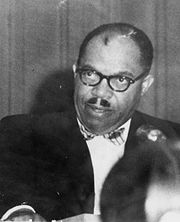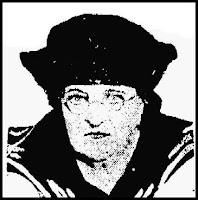Norma Greene, a 34-year-old divorcee, went into cardio-respiratory arrest and died in a Winston-Salem hospital on March 16, 1981. Her death certificate indicates that the arrest was caused by a pulmonary embolism (tissue or air in the lungs) following a recent abortion.
1973: Civil Rights Leader Turned Abortion Profiteer
Reports on death of Evelyn Dudley, age 38, alleged that she was treated at Friendship Medical Center in Chicago on March 16, 1973. Later, at home, she collapsed in the driveway. She was taken to a hospital, where attempts to save her failed.
Her death was due to shock, hemorrhage from a ruptured cervix and vagina, from "remote abortion." Civil rights leader Dr. T.R. Mason Howard (pictured) stated that Evelyn was treated at Friendship for infection sustained in an abortion in Detroit. But Evelyn's brother stated that she had come to Chicago specifically to have the abortion.
Julia Rogers and Dorothy Brown also died after abortions at Friendship Medical Center.
1924: A Mystery Abortion in Chicago
On March 16, 1924, 35-year-old Selma Hedlund died in Chicago's Jefferson Park Hospital (pictured) from complications of an abortion performed that day. The sources says that she died at the crime scene. Nobody was ever positively identified as the abortionist. However, a Carl Carlson, indicated as a person known to Selma, was arrested as an accomplice.
1915: Two Days, Three Deaths
On March 16, 1915, 19-year-old saleslady Hazel Wilcox, who also worked as a cabaret singer, died at a Chicago home from sepsis caused by an abortion believed to have been perpetrated that day by midwife Julia Patera. Patera was held by the coroner on March 20 but the case never went to trial, despite the fact that Elinora Cassidy had died only the previous day after identifying Patera as her abortionist.
In an odd coincidence, a second woman named Hazel died in Chicago on March 16, 1915. Hazel Carr, a 26-year-old homemaker, died in her Chicago home from an abortion performed by an unknown perpetrator.
1905: One of Dr. Lucy Hagenow's Many Victims
On March 16, 1905, 27-year-old seamstress Mary Putnam died at Chicago's Monroe Street Hospital from infection caused by an abortion. May had been brought to the hospital two days earlier, in critical condition, and the police were notified. The party responsible for Mary's death is noted as Dr. Lucy Hagenow, who did her abortions on her own premises and even had a preferred undertaker to haul away the bodies.
Hagenow and a man identified as F. E. MacCordy were arrested by the Coroner's Jury on March 16. MacCordy was president of the MacCordy cigar Company and lived in the same building with Mary. He was about 40 years old.
Louise Derchow, Annie Dorris, Abbia Richards, and Emma Dep in San Francisco, would go on to be linked to over a dozen Chicago abortion deaths:
 |
| Dr. T.R. Mason Howard |
Her death was due to shock, hemorrhage from a ruptured cervix and vagina, from "remote abortion." Civil rights leader Dr. T.R. Mason Howard (pictured) stated that Evelyn was treated at Friendship for infection sustained in an abortion in Detroit. But Evelyn's brother stated that she had come to Chicago specifically to have the abortion.
Julia Rogers and Dorothy Brown also died after abortions at Friendship Medical Center.
1924: A Mystery Abortion in Chicago
On March 16, 1924, 35-year-old Selma Hedlund died in Chicago's Jefferson Park Hospital (pictured) from complications of an abortion performed that day. The sources says that she died at the crime scene. Nobody was ever positively identified as the abortionist. However, a Carl Carlson, indicated as a person known to Selma, was arrested as an accomplice.
1915: Two Days, Three Deaths
On March 16, 1915, 19-year-old saleslady Hazel Wilcox, who also worked as a cabaret singer, died at a Chicago home from sepsis caused by an abortion believed to have been perpetrated that day by midwife Julia Patera. Patera was held by the coroner on March 20 but the case never went to trial, despite the fact that Elinora Cassidy had died only the previous day after identifying Patera as her abortionist.
In an odd coincidence, a second woman named Hazel died in Chicago on March 16, 1915. Hazel Carr, a 26-year-old homemaker, died in her Chicago home from an abortion performed by an unknown perpetrator.
1905: One of Dr. Lucy Hagenow's Many Victims
On March 16, 1905, 27-year-old seamstress Mary Putnam died at Chicago's Monroe Street Hospital from infection caused by an abortion. May had been brought to the hospital two days earlier, in critical condition, and the police were notified. The party responsible for Mary's death is noted as Dr. Lucy Hagenow, who did her abortions on her own premises and even had a preferred undertaker to haul away the bodies.
Hagenow and a man identified as F. E. MacCordy were arrested by the Coroner's Jury on March 16. MacCordy was president of the MacCordy cigar Company and lived in the same building with Mary. He was about 40 years old.
Louise Derchow, Annie Dorris, Abbia Richards, and Emma Dep in San Francisco, would go on to be linked to over a dozen Chicago abortion deaths:
 |
| Dr. Lucy Hagenow |
- 1891: Minnie Deering
- 1892: Sophia Kuhn and Emily Anderson
- 1896: Hannah Carlson
- 1899: Marie Hecht
- 1906: Lola Madison
- 1907: Annie Horvatich
- 1925: Lottie Lowy, Nina H. Pierce, Jean Cohen, Bridget Masterson, and Elizabeth Welter
- 1926: Mary Moorehead
1899: "Life of the Mother" Defense Falls Flat
Harriet "Hattie" Reece was a 25-year-old primary school teacher in
Browning, Illinois. Her husband, Frank, was also a teacher and principal
at the school where Hattie taught. They had been married two and a half
years in 1899, when the events unfolded that ended Hattie's life on
March 16. And the finger pointed at Dr. James W. Aiken,
who seemed to be a bit of a George Tiller precursor -- somebody who
would find a "life of the mother" case in any pregnancy. But unlike
Tiller, Aiken couldn't just buy his way out of trouble. He was found
guilty and sentenced to fifteen years.
1875: Bright Prospects Cut Short
On March 16, 1875, aspiring opera singer Annie Curtis, age 28,
died in New York from an abortion perpetrated by midwife Annie Ihl. Her sad story, with many ups and downs over her short life, is long and complex, and can be read in its entirety here.
1869: A Wife's Final Secret and a Change in the Law
On March 16, 1869, Magdalena Philippi died in New York of pelvic infection caused by an abortion performed on her, evidently, by 48-year-old French immigrant Dr. Gabriel Wolff. Her husband, George, said that his wife had told him about the pregnancy about three weeks before her death.'
She had been attending to her usual household chores and helping out in the saloon until March 1, when, George said, she went to see a doctor. She began to feel unwell that evening and went home early. When George got home he found her in bed and suffering from abdominal pain. She told him that she'd gone to Dr. Wolff, saying that she felt too sick to have another child, so he had given her some medicine "to rid herself of it."
Wolff had said that she'd "feel badly for three or four hours" but would quickly recover. When morning came and Magdalena was still sick, George wanted to call in a different doctor, but Magdalena refused. Wolff made several visits to his patient over the ensuing days, trying one useless remedy after the other, including leeches and mustard plasters, none of which could save Magdalena.
Although Magdalena was four or five months pregnant, prosecutors had no way of proving that she had felt movement in the fetus, so they could not prosecute Dr. Wolff. The next day, a bill was introduced in Albany to eliminate the quickening distinction in prosecuting abortion cases. This would make it easier to prosecute abortionists like Wolff.
On March 16, 1869, Magdalena Philippi died in New York of pelvic infection caused by an abortion performed on her, evidently, by 48-year-old French immigrant Dr. Gabriel Wolff. Her husband, George, said that his wife had told him about the pregnancy about three weeks before her death.'
She had been attending to her usual household chores and helping out in the saloon until March 1, when, George said, she went to see a doctor. She began to feel unwell that evening and went home early. When George got home he found her in bed and suffering from abdominal pain. She told him that she'd gone to Dr. Wolff, saying that she felt too sick to have another child, so he had given her some medicine "to rid herself of it."
Wolff had said that she'd "feel badly for three or four hours" but would quickly recover. When morning came and Magdalena was still sick, George wanted to call in a different doctor, but Magdalena refused. Wolff made several visits to his patient over the ensuing days, trying one useless remedy after the other, including leeches and mustard plasters, none of which could save Magdalena.
Although Magdalena was four or five months pregnant, prosecutors had no way of proving that she had felt movement in the fetus, so they could not prosecute Dr. Wolff. The next day, a bill was introduced in Albany to eliminate the quickening distinction in prosecuting abortion cases. This would make it easier to prosecute abortionists like Wolff.
No comments:
Post a Comment